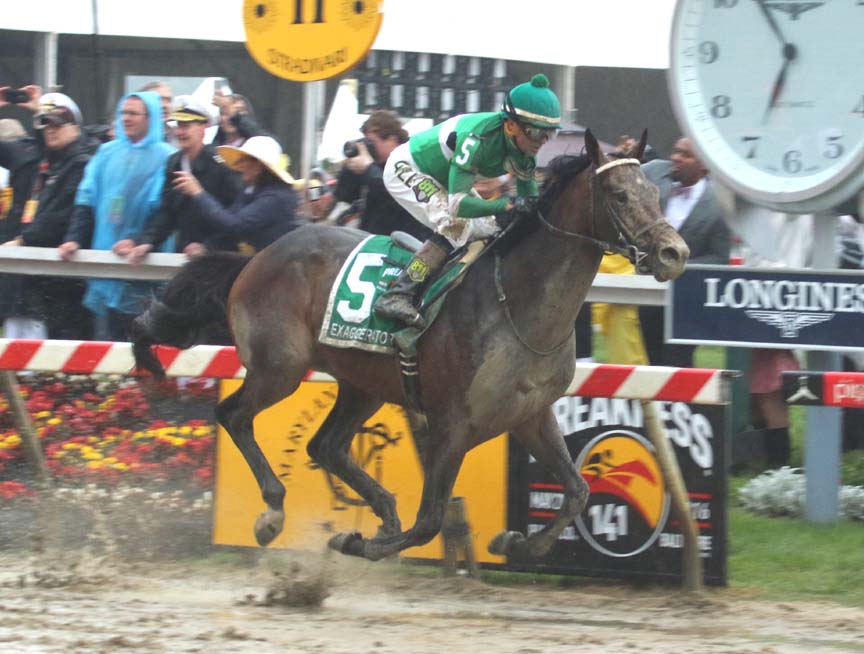History says: It won’t be Exaggerator

Exaggerator was all alone at the finish in the 141st Preakness Stakes. Photo by Laurie Asseo.
by Frank Vespe
Exaggerator, winner of the Grade 1 Preakness and runner-up, to Nyquist, in the Grade 1 Kentucky Derby, will almost certainly go off the favorite in Saturday’s Grade 1 Belmont.
If history is a guide, however, he will not be the one wearing the blanket of carnations after the race.
That’s because Exaggerator has done his best work closing from well off the pace. And though the betting public loves closers in the Belmont — the operative theory being that the longer, 12-furlong distance of the race gives closers plenty of time to get rolling — the truth is that this race rewards tactical speed.
In the Kentucky Derby, Exaggerator, the winner of the Grade 1 Santa Anita Derby in April, trailed by nearly 18 lengths after a half-mile before getting rolling late. He rallied from 15th place to be second across the finish line, chopping 16 1/2 lengths off his deficit.
Then, in the Preakness, Exaggerator was eighth, more than 11 lengths back, after the opening quarter mile before rallying to win going away.
That closing style often works in Louisville and occasionally works in Baltimore. But it rarely works in Elmont, NY.
From 2000 to 2015, the average Kentucky Derby winner trailed the race’s leader by more than eight lengths after the opening half-mile. But the average Belmont winner trailed the leader by just 2.7 lengths after the opening half. What’s more, while the average Belmont Stakes opening half-mile took about 48 1/2 seconds to complete, only one recent Kentucky Derby — Animal Kingdom’s win in 2011 — was that slow.
Indeed, closers, even those thriving in the Kentucky Derby, have very little to show for their Belmont exertions. Since 2000, 19 horses who trailed the leader by 10 or more lengths rallied to finish in the top three in the Kentucky Derby. That number includes five Derby winners (Monarchos, Giacomo, Street Sense, Mine That Bird, and Orb), as well as future stars like Curlin and Paddy O’Prado (to say nothing of less remembered runners like Ice Box and Steppenwolfer).
Of that group, 14 have entered the Belmont starting gate. Their record at Big Sandy: 14-0-2-3.
Were they all longshots? Hardly. The group’s average Belmont Stakes odds are 5.25-1, and five of them have gone off at 5-2 or less.
All in all, Exaggerator is on the wrong side of a lot of history.
Want to make a case for him? It’s not hard. He’ll enter the Belmont as the most accomplished horse in the field, a two-time Grade 1 winner who has won four graded events overall and banked nearly $3 million to date.
What’s more, he’s shown the versatility to run up with the pace, as well as closing into it. In the seven furlong San Vicente, for example, he was just a length behind the leader (and a head behind Nyquist) after a quarter-mile in 22.50 seconds and still just a length back after a half in 44.49 seconds. And in his win in the Delta Downs Jackpot, he made the lead after a half-mile in 47.53 seconds before going on to win.
Still, at the end of the day, Exaggerator has done his best work — in the Derby, Preakness, and Santa Anita Derby — closing into fast early paces. He may get the pace he wants, or he may be too good for his rivals, or he may revert to a stalk-and-pounce style in the Belmont.
But do you want to take short odds on any of those propositions?







